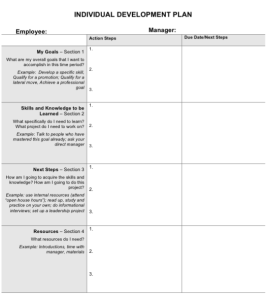Individual Development Plans – help grow your team members
In any organization – especially sales organizations, it is vitally important to develop, coach and grow your team. If you are not providing opportunities for growth and development to your direct reports as a manager it can have negative consequences. Most notably, your employees will look for these “growth” opportunities outside of your organization and that will be costly and time-consuming.
For instance, having an ERP software solution implemented in your business with the aid of professionals like the ones from Syte Consulting Group could attract in-demand talent and evolve the financial systems of your business. Most next-generation workers have grown up with the help of seamless technology. Incorporating such practices into a business might give employees a boost in their self-confidence and keep them from looking elsewhere.
 By definition, “an individual development plan (IDP) is a tool to assist employees in career and personal development. Its primary purpose is to help employees reach short and long-term career goals, as well as improve current job performance.” I like to think of it as a 2-way commitment between the sales rep and their sales leader to enhance immediate and long-term success. This type of commitment is often overlooked with the day-to-day tasks and priorities (I am sure you have heard of that little thing we called a “quota”!)
By definition, “an individual development plan (IDP) is a tool to assist employees in career and personal development. Its primary purpose is to help employees reach short and long-term career goals, as well as improve current job performance.” I like to think of it as a 2-way commitment between the sales rep and their sales leader to enhance immediate and long-term success. This type of commitment is often overlooked with the day-to-day tasks and priorities (I am sure you have heard of that little thing we called a “quota”!)
IDP’s should be initially created and then driven by the sales rep with the full support of their leadership team. For example, if you want someone to be making better pitches, give them a few ideas on what to say, and try to inspire them rather than tell them they’re doing things wrong. Life insurance companies often do this with their agents – check it out here to see if it could also work for you. Below is a list of leadership duties that should be considered to make the process a success.
- Meet with the sales rep to discuss their individual development plan.
- Provide detailed feedback on the goals they have set for themselves. (are they realistic goals, are they SMART goals?)
- Provide suggestions and action items for their development activities.
- Help set realistic timelines for the action items
- Help remove any foreseeable roadblocks they may encounter.
- Schedule time each quarter to review and discuss progress as well as make revisions or updates as needed.
- Acknowledge accomplishments along the way.
- Finally, make sure you give opportunities to utilize the skills that were developed. We want them to use that knowledge, not lose it.
To engage your team and get them excited to map out their future, a best practice is to lead by example and share an IDP that I have created along the way. Overall, you will see an increase in team members overall satisfaction in their current role and a clear focus on their future. I am sure you are asking yourself “What’s in it for me…?” I could tell you that the satisfaction seeing a team member flourish and grow is it, but a sales leader, you should be looking for your replacement. Someone who can take over your role when you move up.
TIP: Remember to create and work on your own IDP to continue growing as a sales leader.
Example IDP Template:



